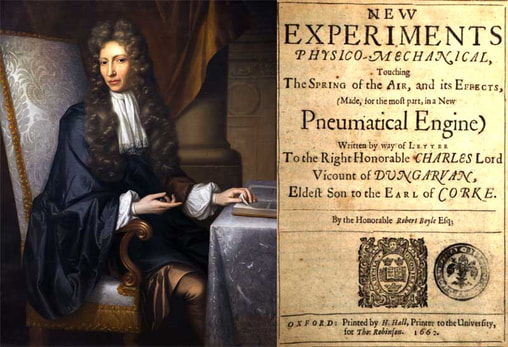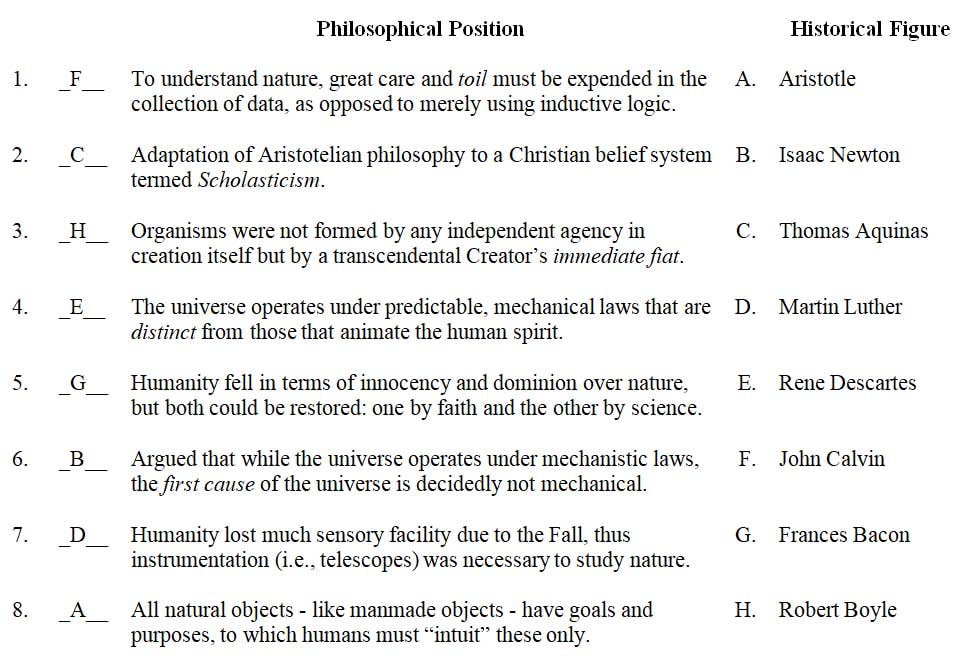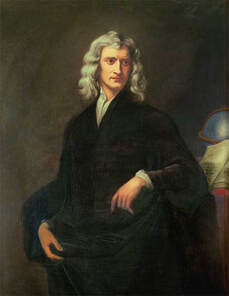Assessment Items for Philosophy and History of Science unit
|
For IDT 7100 - Online and Blended Assessment, I had to develop a variety of assessment items, taking into consideration the following:
Informed by many articles and websites on how to develop effective assessment items, I put together exam questions in True/False, Completion, Multiple Choice, and Matching formats. After these items were developed for face-to-face administration, they were reformatted for online delivery using an app for test-taking. |
Learning Objectives for the Unit
|
True/ False
True/ False. If the below statement is true, circle T; if false, circle F:
Completion
Completion. Complete each statement by filling in the blanks.
|
Multiple Choice
Multiple Choice. Write in the blank provided the best answer for each of the following questions (2 points each)
1. _B_ Which of the below statements does NOT reflect beliefs that contributed to the development of empirical science? A. Since the Biblical God is one of law and order, nature must similarly follow laws with predictable and mathematical precision. B. Since everything we observe in nature came into being by the Biblical God, nature by necessity is also divine. C. The Adamic fall instilled in humanity cognitive depravity, making human “reason” alone insufficient for acquiring reliable knowledge about nature. D. Since the fall impaired human’s sensory channels (vision, hearing, smell), highly technical instrumentation must be used to study nature. LO #2 _D_ 2. If you were Johannes Kepler, what step of the scientific method would characterize the statement, “After much observation and quantitative analysis, the orbit by which Mars revolves around the sun is elliptical.” A. Formulating a hypothesis B. Developing testable experiment C. Collecting data and calculations D. Drawing conclusions LO's #3, 4 _A_ 3. Which of the below statements describes early Greek thought that inhibited the consolidation of an empirical scientific method? A. Since the Greek gods are capricious and unpredictable, nature is similarly unknowable. B. Because the Greek deities were transcendental and existed before matter, they had total control over the material world. C. Greek deities generated a material world that operates under predictable laws, much like a clock. D. Since material objects do not have any teleological purpose, the laws influencing them are regular. LO #5 _A_ 4. If you believed in a geocentric (Earth-centered) universe, which of the below observations would generate significant doubt for this position? A. Elliptical orbits of planets better explain their relative motions to the Sun. B. Earth appears to be unmoving from the perspective of an earthbound observer. C. The sun appears to revolve around Earth once per day, in a 24-hour period. D. The stars appear to be embedded within a celestial sphere, rotating about Earth. LO #4 Matching
MATCHING – Place the correct letter corresponding to the historical figure at the left to their philosophical position characterized at right in the space provided – each letter is used only once. (1 point each)
|
References:
Anderson, L. W., Krathwohl, D. R., & Bloom, B. S. (2001). A taxonomy for learning, teaching, and assessing: A revision of Bloom's taxonomy of educational objectives. Allyn & Bacon.
Clay, B., & Root, E. (2001). Is this a trick question? A short guide to writing effective test questions. Retrieved from: https://www.k-state.edu/ksde/alp/resources/Handout-Module6.pdf
Harrison, P. (2007). The fall of man and the foundations of science. Cambridge University Press.
Harrison, P. (2001). The Bible, Protestantism, and the rise of natural science (No. 10). Cambridge University Press.
Klaaren, E. M. (1977). Religious origins of modern science: belief in creation in seventeenth-century thought. William B. Eerdman’s Publishing: Grand Rapids, MI.
Pearcey, N. & Paxton, C.B. (1997). The soul of science: Christian faith and natural philosophy. Wheaton, IL: Crossway Books
Anderson, L. W., Krathwohl, D. R., & Bloom, B. S. (2001). A taxonomy for learning, teaching, and assessing: A revision of Bloom's taxonomy of educational objectives. Allyn & Bacon.
Clay, B., & Root, E. (2001). Is this a trick question? A short guide to writing effective test questions. Retrieved from: https://www.k-state.edu/ksde/alp/resources/Handout-Module6.pdf
Harrison, P. (2007). The fall of man and the foundations of science. Cambridge University Press.
Harrison, P. (2001). The Bible, Protestantism, and the rise of natural science (No. 10). Cambridge University Press.
Klaaren, E. M. (1977). Religious origins of modern science: belief in creation in seventeenth-century thought. William B. Eerdman’s Publishing: Grand Rapids, MI.
Pearcey, N. & Paxton, C.B. (1997). The soul of science: Christian faith and natural philosophy. Wheaton, IL: Crossway Books
Image Credits:
Image credit of the Milky Way Galaxy: NASA/JPL-Caltech/R. Hurt (SSC/Caltech). Retrieved from: https://astronomynow.com/2015/06/07/charting-the-milky-way-from-the-inside-out/
Image of vintage periodic table of elements retrieved from: https://printmeposter.com/blog/periodic-table-poster-efficient-visual-aid-for-a-chemistry-class-and-a-great-decoration-for-walls/
Image of Michelangelo's God and Adam's hands retrieved from: https://experimentaltheology.blogspot.com/2010/05/michelangelo-and-neuroanatomy.html
Image of Robert Boyle retrieved from: https://www.dkfindout.com/us/science/famous-scientists/robert-boyle/
Image of Isaac Newton retrieved from: https://www.history.com/.image/t_share/MTU3ODc5MDg1MzU5NTcyMjk3/sir-isaac-newton.jpg
Image of Robert Boyle's manuscript cover retrieved from: https://allthingsdiving.com/timeline/robert-boyle-law-ideal-gas/
Image credit of the Milky Way Galaxy: NASA/JPL-Caltech/R. Hurt (SSC/Caltech). Retrieved from: https://astronomynow.com/2015/06/07/charting-the-milky-way-from-the-inside-out/
Image of vintage periodic table of elements retrieved from: https://printmeposter.com/blog/periodic-table-poster-efficient-visual-aid-for-a-chemistry-class-and-a-great-decoration-for-walls/
Image of Michelangelo's God and Adam's hands retrieved from: https://experimentaltheology.blogspot.com/2010/05/michelangelo-and-neuroanatomy.html
Image of Robert Boyle retrieved from: https://www.dkfindout.com/us/science/famous-scientists/robert-boyle/
Image of Isaac Newton retrieved from: https://www.history.com/.image/t_share/MTU3ODc5MDg1MzU5NTcyMjk3/sir-isaac-newton.jpg
Image of Robert Boyle's manuscript cover retrieved from: https://allthingsdiving.com/timeline/robert-boyle-law-ideal-gas/



